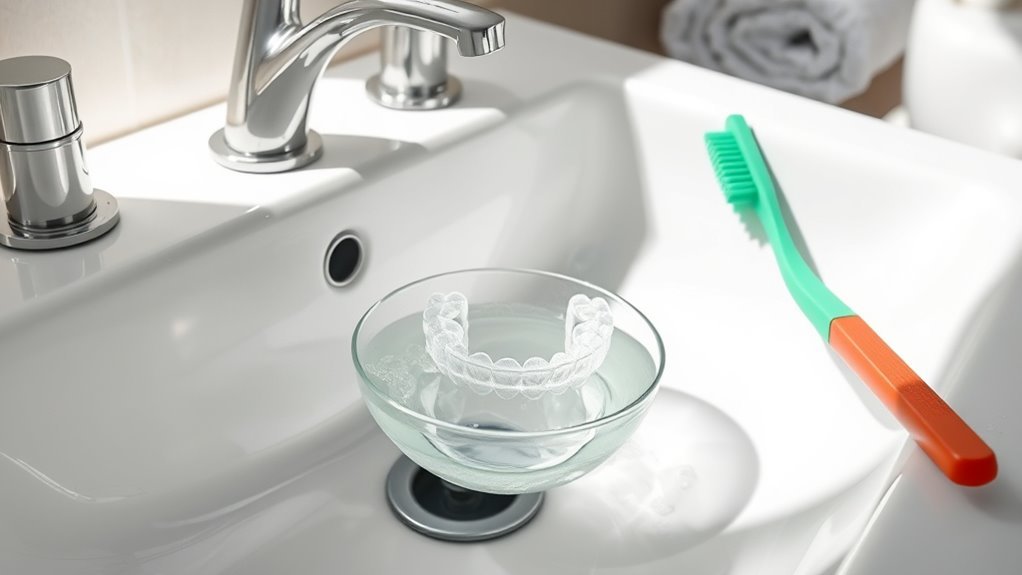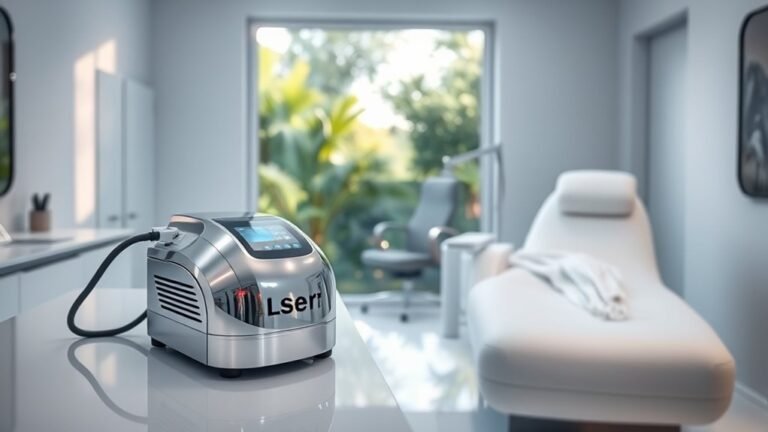How Often to Clean Retainer
You should clean your retainer daily to maintain ideal oral health. Use a soft toothbrush with mild soap to remove debris after each use. For a deeper clean, soak it weekly in a solution of white vinegar and water or baking soda. This routine prevents bacterial buildup and prolongs the life of the retainer. Inspect it regularly for wear and damage, and you’ll discover more tips for keeping your retainer in great shape.
##
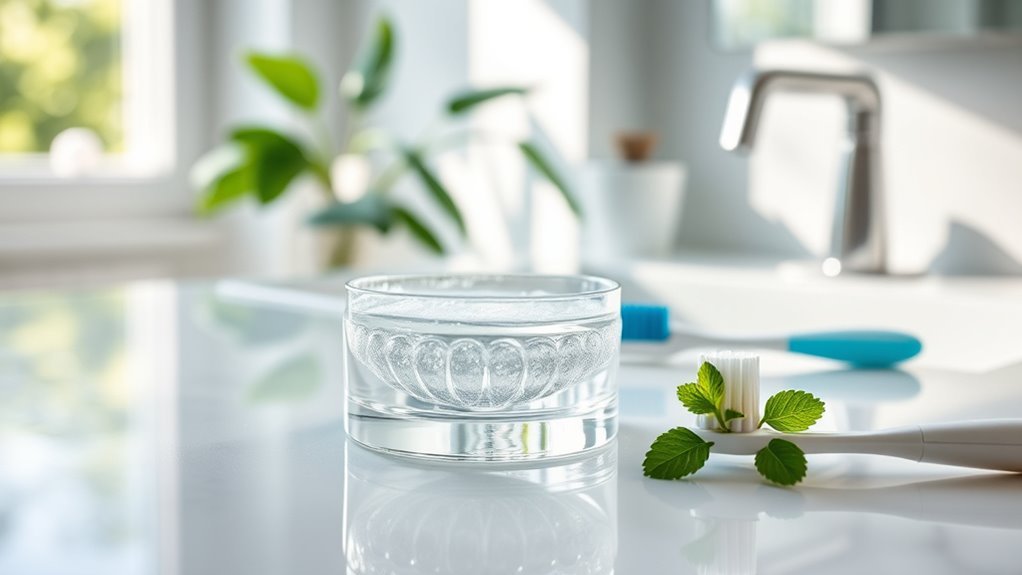
Maintaining proper oral hygiene is essential, especially when it comes to caring for your retainer. In this article, you’ll discover valuable insights on how often you should clean your retainer to prevent bacterial buildup and ensure optimal oral health. We’ll cover the best practices for daily cleaning, signs that indicate when to step up your cleaning routine, and the benefits of using specialized cleaning solutions. By following these guidelines, you’ll not only maintain a fresh retainer but also enjoy the confidence of a healthy smile for years to come.
Preparation For Cleaning
Before diving into the cleaning process, it’s important to gather all necessary supplies to guarantee a thorough and effective cleaning routine for your retainer. Different retainer types, like fixed or removable, may require specific care methods, so be aware of what yours needs. Consider your cleaning frequency; daily maintenance can prevent build-up and prolong the life of your retainer. You’ll want to have a soft toothbrush, mild soap, or a specialized retainer cleaner on hand. Additionally, a container for soaking can be useful. Knowing your retainer type will help you select the right products and techniques, ensuring your cleaning is both efficient and gentle. With the right preparation, you’ll keep your retainer in excellent condition.
Tools and Chemical Required
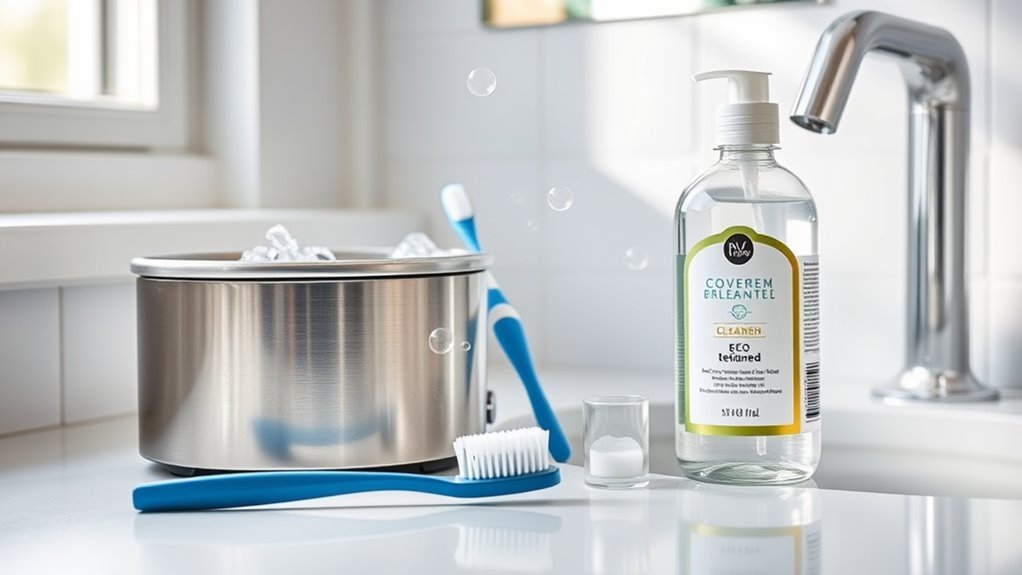
Cleaning your retainer requires the right tools and chemicals to guarantee effective sanitation without causing damage. To maintain your retainer’s integrity, you’ll need specific maintenance tools and cleaning solutions. Here’s a quick reference to help you gather what you need:
| Maintenance Tools | Cleaning Solutions | Frequency of Use |
|---|---|---|
| Soft toothbrush | Mild dish soap | Daily |
| Retainer case | White vinegar | Weekly |
| Soft cloth | Baking soda | Bi-weekly |
| Water (distilled) | Hydrogen peroxide | Monthly |
| Floss | Retainer cleaning tablets | As needed |
With these tools and cleaning solutions at hand, you can effectively maintain your retainer, ensuring it stays fresh and functional.
How to Clean:
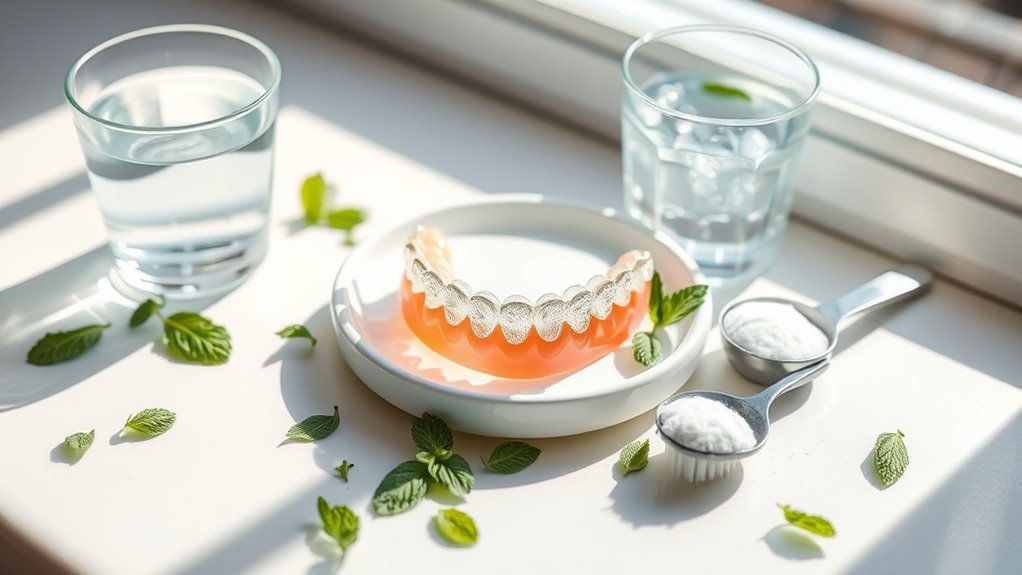
Step 1: Rinse Your Retainer
- Begin by rinsing your retainer under lukewarm water.
- This initial rinse helps to remove any loose debris or food particles that may have accumulated.
Step 2: Choose Your Cleaning Method
- Decide on a suitable cleaning method for your retainer:
- Soft Toothbrush with Mild Soap:
- Use a soft-bristled toothbrush to gently scrub the retainer.
- Apply a small amount of mild soap to the brush and clean all surfaces of the retainer.
- Specialized Retainer Cleaner:
- If you have a retainer cleaner, follow the instructions on the packaging for the best results.
- Important: Avoid using harsh chemicals, as they can damage the material of your retainer.
Step 3: Soak for a Deeper Clean
- For a more thorough cleaning, you can soak your retainer:
- Water and Vinegar Solution:
- Mix equal parts of water and white vinegar in a container.
- Soak your retainer for about 15-30 minutes.
- Baking Soda Solution:
- Dissolve a tablespoon of baking soda in a cup of water.
- Soak the retainer in this solution for 15-30 minutes.
- After soaking, rinse the retainer under lukewarm water to remove any residue.
Step 4: Cleaning Frequency
- Aim to clean your retainer daily:
- This helps prevent plaque buildup and unpleasant odors.
- Additionally, perform a deeper clean by soaking the retainer at least once a week:
- This ensures that your retainer remains fresh and functional over time.
Safety Consideration
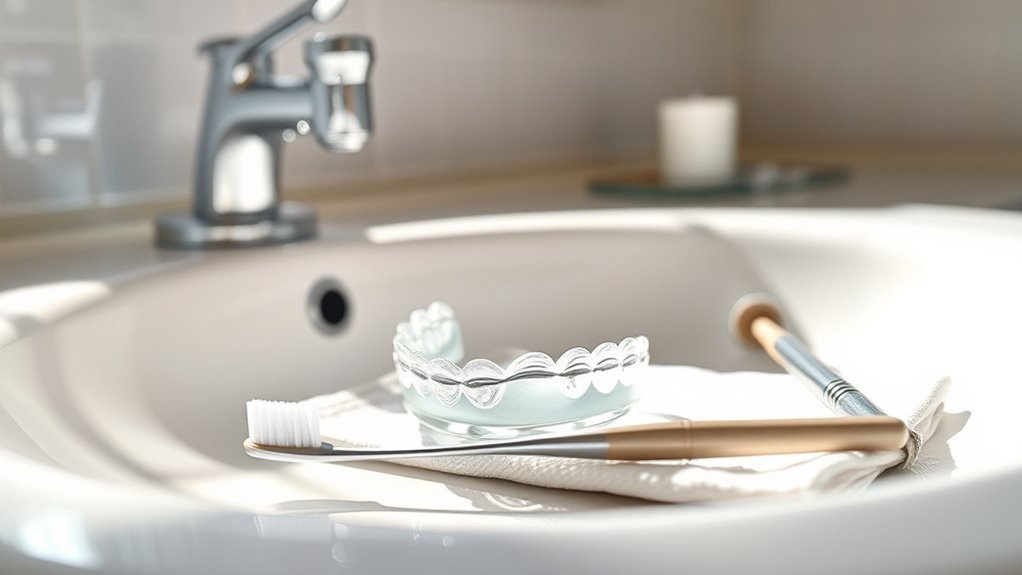
When it comes to cleaning your retainer, safety should always be a top priority. Neglecting proper cleaning can lead to significant health risks. Bacteria growth on your retainer not only affects your oral hygiene but can also result in infections or even gum disease. It’s crucial to use safe cleaning methods that won’t harm the material of your retainer. Avoid harsh chemicals, as they can cause damage and worsen bacteria proliferation. Instead, opt for gentler, dentist-recommended cleaning solutions. Regularly inspecting your retainer for any signs of wear or damage is also important. By prioritizing safety, you guarantee your retainer remains effective and your mouth stays healthy, allowing you to enjoy the freedom of a confident smile.
Tips to keep clean for long time
Although it may seem challenging, keeping your retainer clean for an extended period is entirely achievable with the right habits. Consistent daily maintenance and proper storage are key to ensuring your retainer stays in excellent condition. Here are some tips to help you maintain cleanliness:
- Rinse your retainer with water after each use to remove debris.
- Brush your retainer gently with a soft toothbrush and mild soap weekly.
- Store your retainer in a protective case when not in use to prevent damage.
- Avoid exposing your retainer to extreme temperatures, which can warp its shape.
Frequently Asked Questions
Can I Use Toothpaste to Clean My Retainer?
You shouldn’t use toothpaste to clean your retainer, as it can be abrasive and lead to scratches, harboring bacteria. Instead, consider toothpaste alternatives like mild soap or a retainer-specific cleaner. For best cleaning frequency, aim to clean your retainer daily to prevent buildup and maintain hygiene. This approach not only preserves your retainer but also guarantees your oral health remains in top shape, giving you the freedom to smile confidently.
How Can I Tell if My Retainer Needs Cleaning?
You can tell if your retainer needs cleaning through visual inspection and odor detection. If you notice discoloration, debris, or a cloudy appearance, it’s time for a thorough clean. Additionally, if you detect any unpleasant smells, it’s a sign that bacteria might be building up. Regular checks guarantee your retainer stays fresh and functional, allowing you the freedom to maintain your oral health without worry. Prioritize cleanliness for a confident smile!
What Happens if I Don’T Clean My Retainer Regularly?
If you don’t clean your retainer regularly, retainer bacteria can build up, leading to foul odors and potential oral hygiene issues. This can result in bad breath, gum disease, or even tooth decay. Neglecting to maintain your retainer not only affects its functionality but also jeopardizes your overall dental health. To keep your mouth fresh and your retainer effective, make cleaning a consistent part of your daily routine.
Is It Safe to Soak My Retainer Overnight?
Yes, it’s generally safe to soak your retainer overnight, but you need to choose the right solution. Avoid harsh chemicals that could damage the material. Instead, opt for a gentle cleaning solution specifically designed for retainers or a mix of water and vinegar. This method helps eliminate bacteria and keeps your retainer fresh. Just remember to rinse thoroughly before putting it back in your mouth for ideal retainer safety!
Can I Use Vinegar to Clean My Retainer?
You can use a vinegar solution to clean your retainer, but it’s not the only option. Vinegar’s acidity can help break down stubborn deposits, but it can also weaken the retainer material over time. Consider alternating cleaning methods—like using mild soap or a specialized retainer cleaner—to maintain its integrity. Remember, balance is key; while vinegar can be effective, gentle care guarantees your retainer lasts longer and stays safe for your smile.
